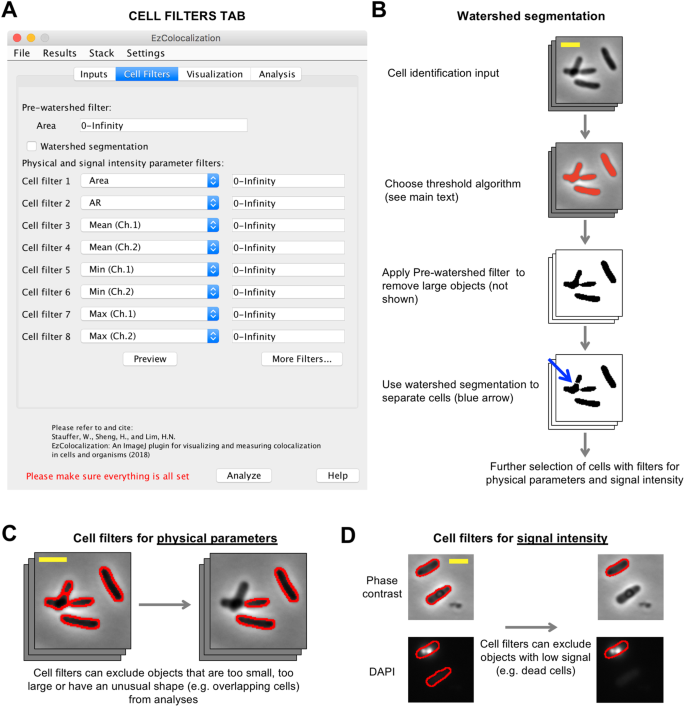

In your case, I would suggest giving the former a try. So far, your attempts fall more into the latter category. The Fiji wiki page on Segmentation discusses two primary ways of approaching image segmentation: the Trainable Weka Segmentation plugin, and a more flexible macro-based workflow. Overlapping objects can be a tough problem. Pleas help (either with the first or second code!) Thanks! :) Run("Auto Threshold", "method=Otsu white") ImageCalculator("Subtract create", a,"_seed") Run("GreyscaleReconstruct ", "mask="+a+" seed=_seed create") I also tried using GreyscaleReconstruct but I was not that successful either. I am using the macros on a stack of images. Run("Analyze Particles.", "size=200-2000 circularity=0.50-1.00 show= display exclude clear summarize add in_situ") Run("Auto Threshold", "method=Yen white stack") Run("Subtract Background.", "rolling=5 light sliding stack") However, I have a hard time removing the overlap between cells and for the program to distinguish between the clumps. So here we range from 1 to 9.I have been trying to make a macros for counting the cells in the image. Each pixel representing a maxima will have the value of 255 so dividing the total by 255 will give you the number of detected maxima/foci in each region defined by the nuclear stain. (If this doesn't show up, you can change what is measured under Analyze/Set Measurements). The useful output is RawIntDen - the sum of all the pixels in that region. The results are then presented for the ROI by ROI measurement. This will access the ROI shapes we made by Analyze Particles aboveĬheck Show All - Uncheck and recheck it is already Open the ROI manager - Analyze/Tools/ROI Manager. When you click OK above with the output type of "Single points" a new binary image is generated with a single pixel for each local maxima. This obviously may present some useful information and may be worth the extra steps. If you want the number of foci in each nucleus. Here we have 84 spots between the 15 nuclei so an average of 5.6 per cell. Toggling the "preview point selection" is a good way of assessing this. Count the number of fociĪdjust the noise tolerance to get a good count. Run analyze particles using this image - The smoothing and lower threshold may give a better outline of the nucleus as well as help with touching objects. Watershed - Separate objects at Process/Binary/Watershed Threshold the image - Ctrl+Shift+T - choosing an value which covers the nuclei well even if some touch. Smoothing the image - Ctrl+Shift+S or Process/Smooth - can help with the next step

If the nuclei are crowded and touching you might have to do a little more work to get to this point. "Summarize" gives you a little pop up with the total number.Īfter pressing OK we count 15, which looks right. "Clear results" removes previous measurements, which helps to reduce the chance of errors. "Display results" means numbers pop up in table.

Overlay outlines gives a nice output to check the accuracy of the process. Here I have set a size discrimination of over >200 px to miss out the little things that aren't nuclei. Threshold the image - Ctrl+Shift+T - choosing an optimal value which makes each nucleus has a single region highlighted Open the image and if required split channels This is relatively easy as nuclei tend to be fairly well separated, similar in size and brightly stained.


 0 kommentar(er)
0 kommentar(er)
